This homely traditional Vegetable Stew and Dumplings recipe is easy to prepare and is packed with tasty every-day vegetables, potatoes, and barley, and delicious fluffy, dumplings.
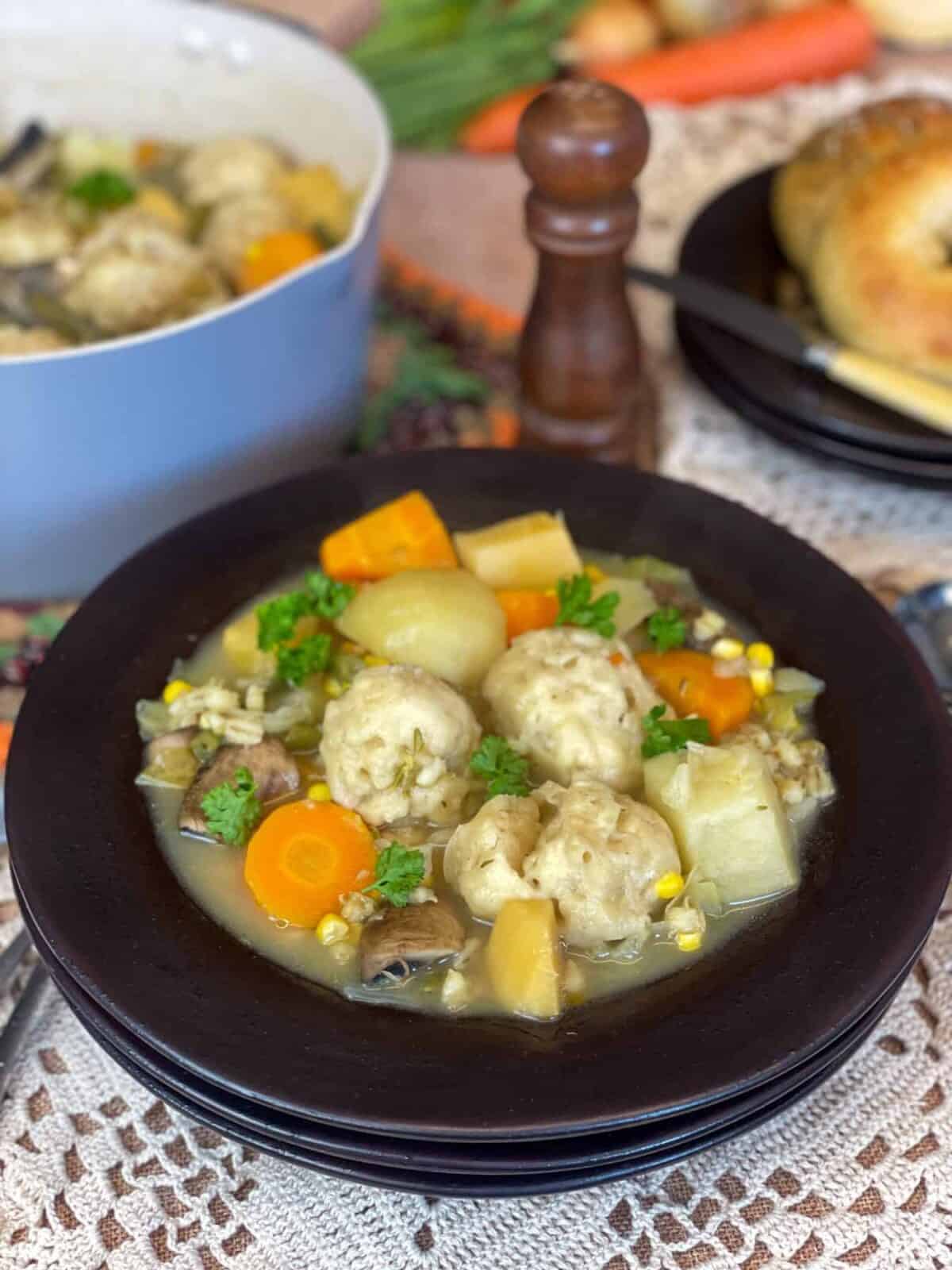
My family loves a bowl of this traditional vegetable stew and dumplings at any season of the year, including summer as we live in Scotland which frequently has 4 seasons in one day.
Jump to:
Origin of vegetable stew and dumplings
If you would like to find out about the origins of vegetable stew then click the toggle '🥣' below.
🥣 Origin of vegetable stew and dumplings
The concept of stew is universal and has been around since ancient times, going back to when humans first discovered how to cook food over fire. A few examples are: "ratatouille" in France, "chickpea stew" in Spain, "tagines" in Morocco, ''Irish stew'' in Ireland, ''mince and tatties' in Scotland, beef stew in England, and chuck wagon stew in United States.
Many medieval peasant stews or pottages were made with vegetables and foraged plants as meat was expensive, and hunting was controlled by wealthy land owners. Vegetables such as cabbage, turnip, peas, beans, and leeks, and grains such as oats and barley, were easy to source for the stew-pot. As such, stews were commonly filled with garden-grown vegetables, edible leaves, wild plants, and herbs.
The traditional Scottish hotchpotch soup, which due to its thickness is often classified as a stew, traditionally included lettuce which was an ingredient that might seem unusual to us today but as many folk were suspicious of raw vegetables including salad ones they were also cooked in the stew pot.
Add dumplings to stews was a frugal way to bulk out the meal that may only have been made up with vegetables, beans and grains, or small amounts of meat.
Traditional American dumplings
In The Little House on the Prairie series of books and films, set in the American Midwest during the late 19th Century, Laura Ingalls describes instances of her mother preparing stew and dumplings. Stew and dumplings made an appearance at their Thanksgiving dinner. Similarly, it provided sustenance on the rugged roadside while the family journeyed by wagon, carrying all their possessions, in search of an ideal location to build their home. This hearty meal also graced the dinner table when they hosted a family friend, Mr. Edwards, in their newly built wooden house on the prairie.
Ma Ingalls dumplings were prepared with white flour, baking soda, salt, and buttermilk, and cooked directly on top of the stew. Also, when Mr Edwards visited for dinner, the dumplings were cooked within a Jack rabbit stew, and served alongside cornbread and molasses. Laura Ingles describes her mothers dumplings as being similar to sour milk biscuits, although the dumplings did not need to be rolled out but simply dropped into the stew as they were of a much wetter consistency.
For more information, see The Little House Cookbook, Frontier Foods from Laura Ingalls Wilder's Classic Stories [Third Edition], by Barbara M. Walker [1979].
Traditional British dumplings
Suet dumplings have been a staple in traditional British cooking for centuries, but when the pioneers settled in America, suet was not an easy ingredient to obtain so early American recipes for dumplings do not contain suet. Suet, is a type of animal fat and throughout the centuries it was cheap and readily available compared to other ingredients so they were useful in making a sparse meal. Flour dumplings made with suet are light and fluffy, and they soak up the flavours of whatever stew they happen to be cooking in.
Adding dumplings to stews was popular during the 18th and 19th centuries, during the Industrial Revolution. This was an era when cheap, filling, and nutritious meals were needed to feed large, working-class families. Stews, soups, and broths could be easily bulked up with the addition of dumplings, providing a more filling meal.
One of the most popular British stews that feature suet dumplings is beef stew and dumplings. Although this traditional meal is a frequent dish during the colder months in modern times, it was a staple all year round for frugal families.
In the popular 19th century cook book Mrs Beeton's Book of Household Management [1861] Isabella Beeton describes a plain family dinner as being -
''mutton, carrots, mashed turnips, suet dumplings, and caper sauce: the broth should be served first, and a little rice or pearl barley should be boiled with it along with the meat''
Incidentally, the pudding to follow this meal was a rolled jam pudding which was likely prepared with suet as well.
Old-fashioned puddings prepared with suet
Old-fashioned British dumplings are close cousins of the traditional British savoury and sweet puddings such as - Scottish haggis, sweet clootie dumpling, spotted dick [steamed pudding], steamed jam pudding, and Christmas pudding otherwise known historically as plum pudding and although a sweet dessert now, it was originally served along with the savoury dinner.
In the old cookery book The Art of Cookery Made Plain and Easy [1805], Hanna Glasse has a recipe for Suet Dumplings which is listed under the ''Of Puddings'' chapter. However, it is not clear whether Glasses' dumplings are intended to be served along with the savoury course or the dessert course, as a Steak Pudding is before the Suet Dumplings recipe, whereas the recipe after the Suet Dumplings is for a Potato Pudding which is finished off by having sugar thrown over it!
Glasses' Suet Dumplings are prepared with flour, milk, eggs, suet, currants, salt and ginger, with the mixture formed into the size of a large turkey's egg, before being flattened and cooked in boiling water.
Vegetable suet
Atora, the most common brand of suet, was the first manufactured animal suet in 1893, and vegetable suet appeared sometime after. Atora vegetable suet is made with a blend of vegetable oils and wheat flour and comes in the form of little, light coloured, firm, but easily squashed pellets. It doesn't require any preparation before being used in a recipe as it can be simply added to the recipe as it comes, and during cooking it melts into the dumpling or pudding, and if cooked properly it creates a deliciously light and fluffy texture.
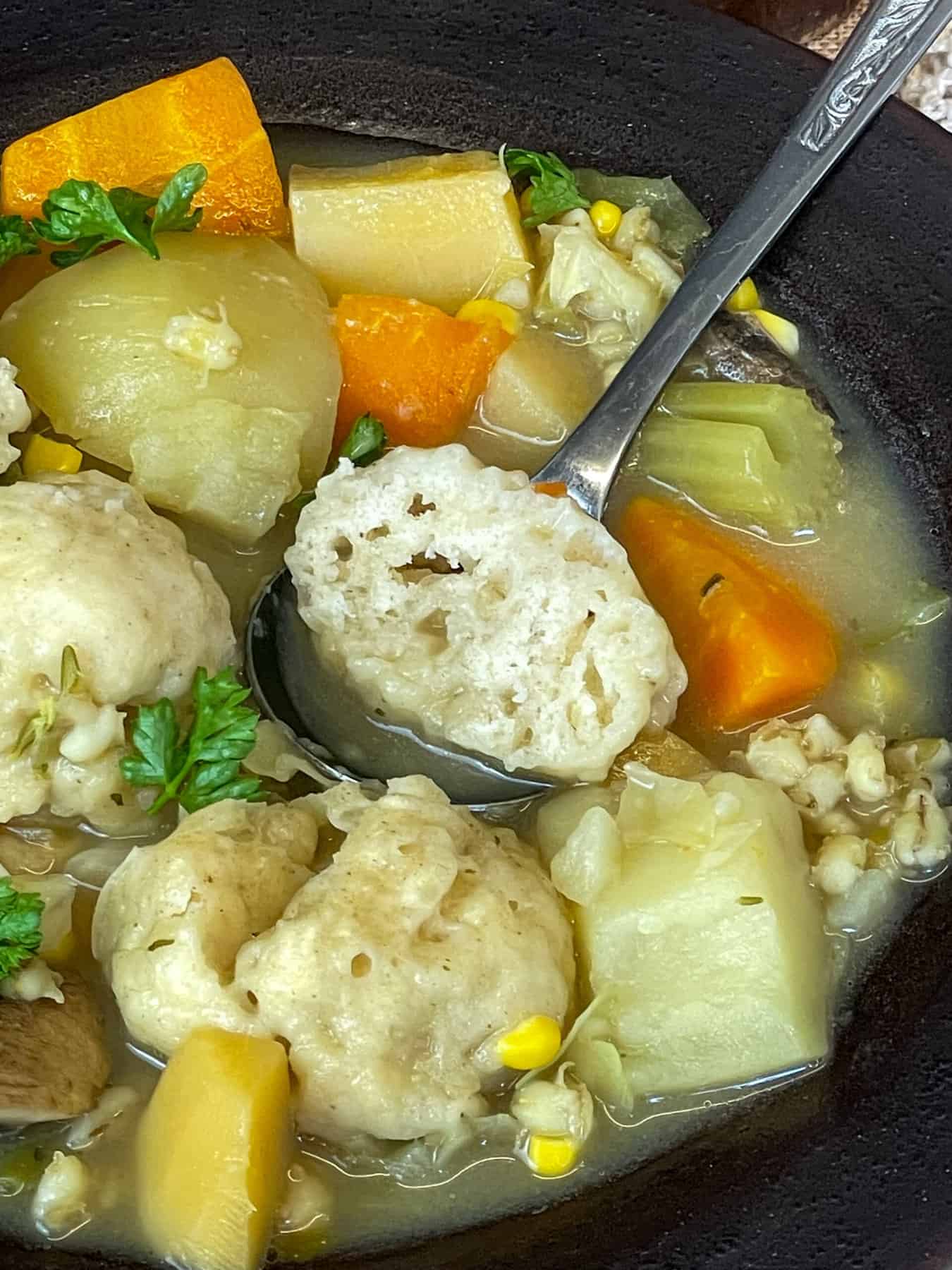
How to prepare
Preparing this traditional vegetable stew with dumplings is fairly straightforward and requires approximately an hour of cooking. As with all stews, the flavours tend to become even more delicious a day or two after it's prepared, as the ingredients have time to blend together beautifully. This means you can save time by making the stew a day or two in advance.
However, the dumplings are at their best right after they're cooked so, if you decide to prepare the vegetable stew ahead of time, when you require dinner - you can simply bring it to a boil, add fresh dumplings, simmer for 20 minutes, and have dinner ready in about thirty minutes.
Prepare the vegetable stew
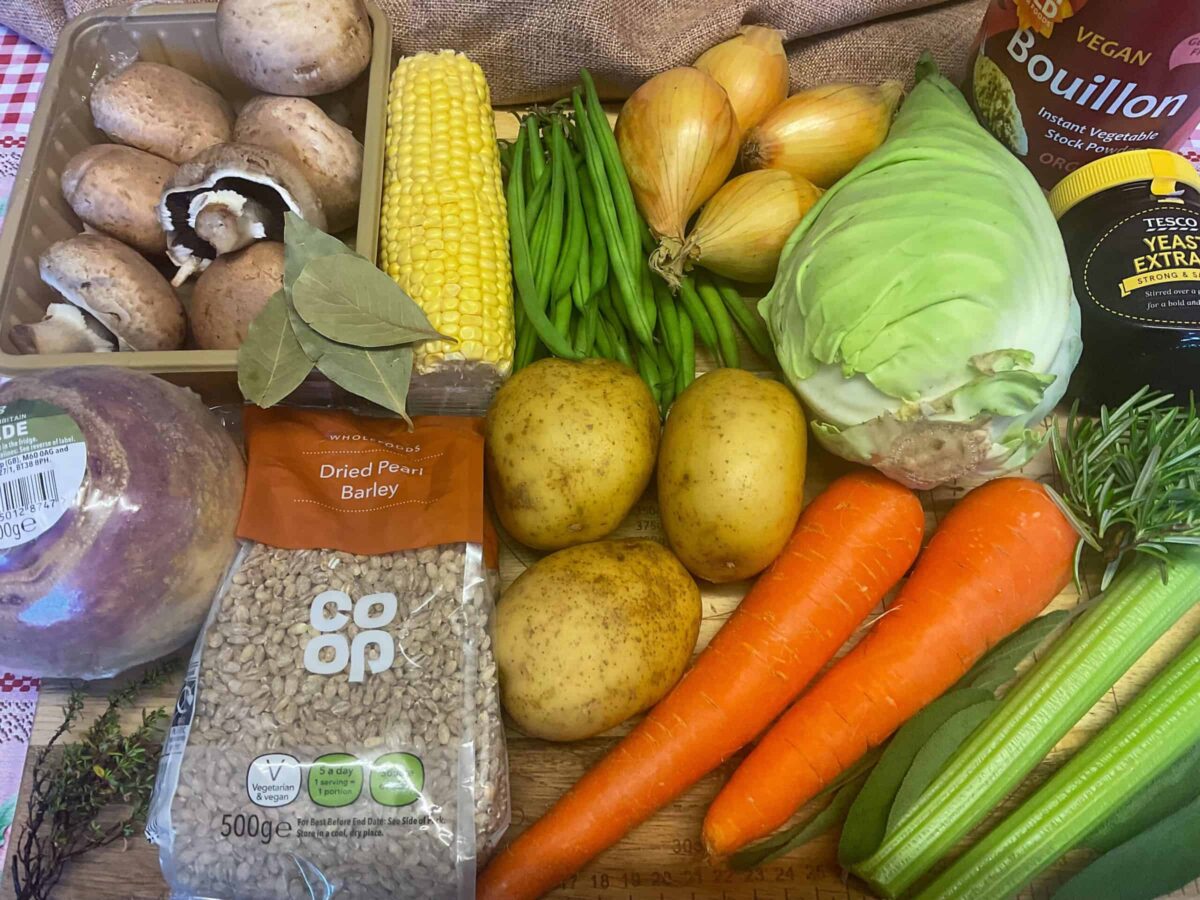
Step 1: Gather and prepare all the ingredients.
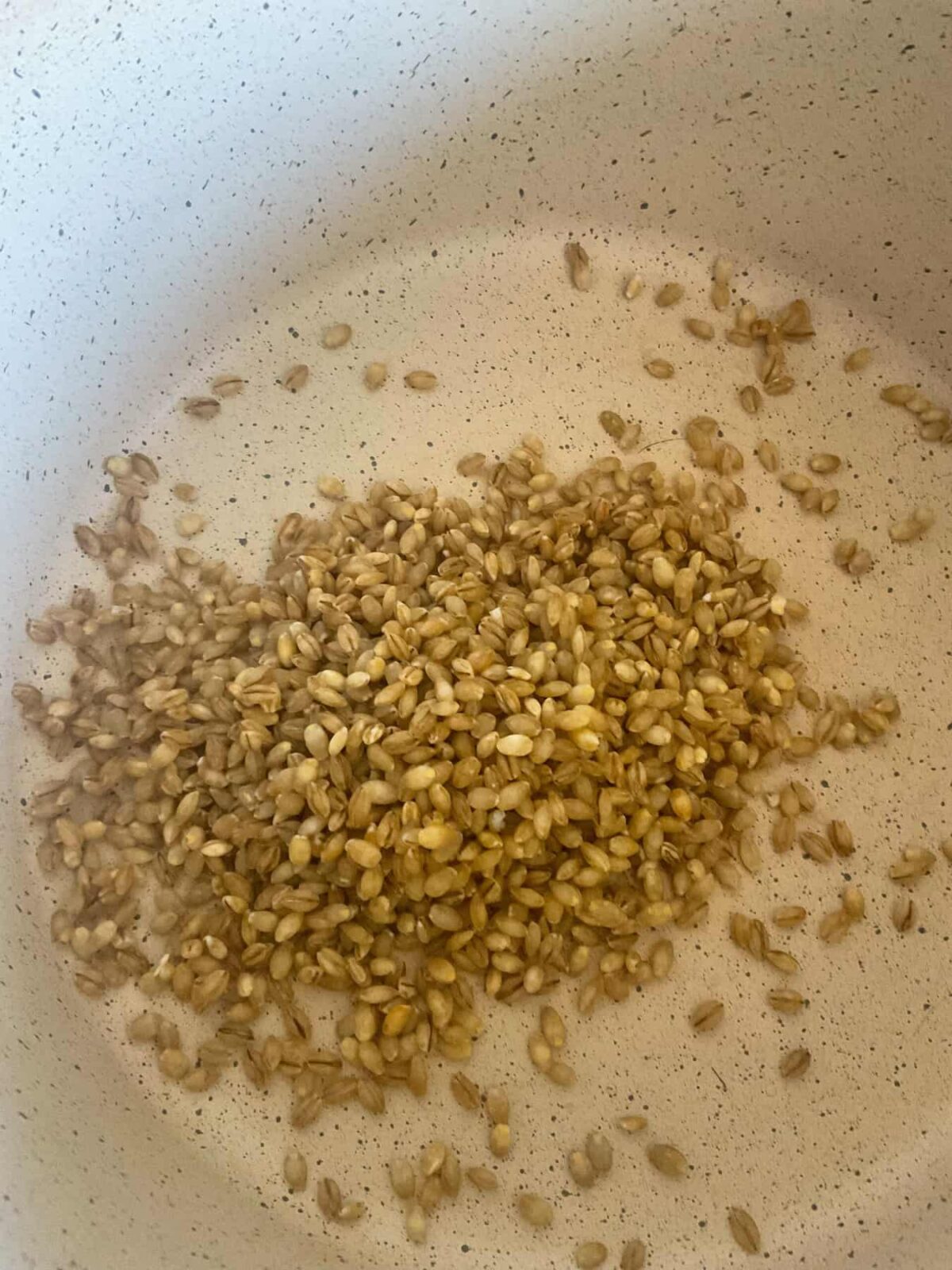
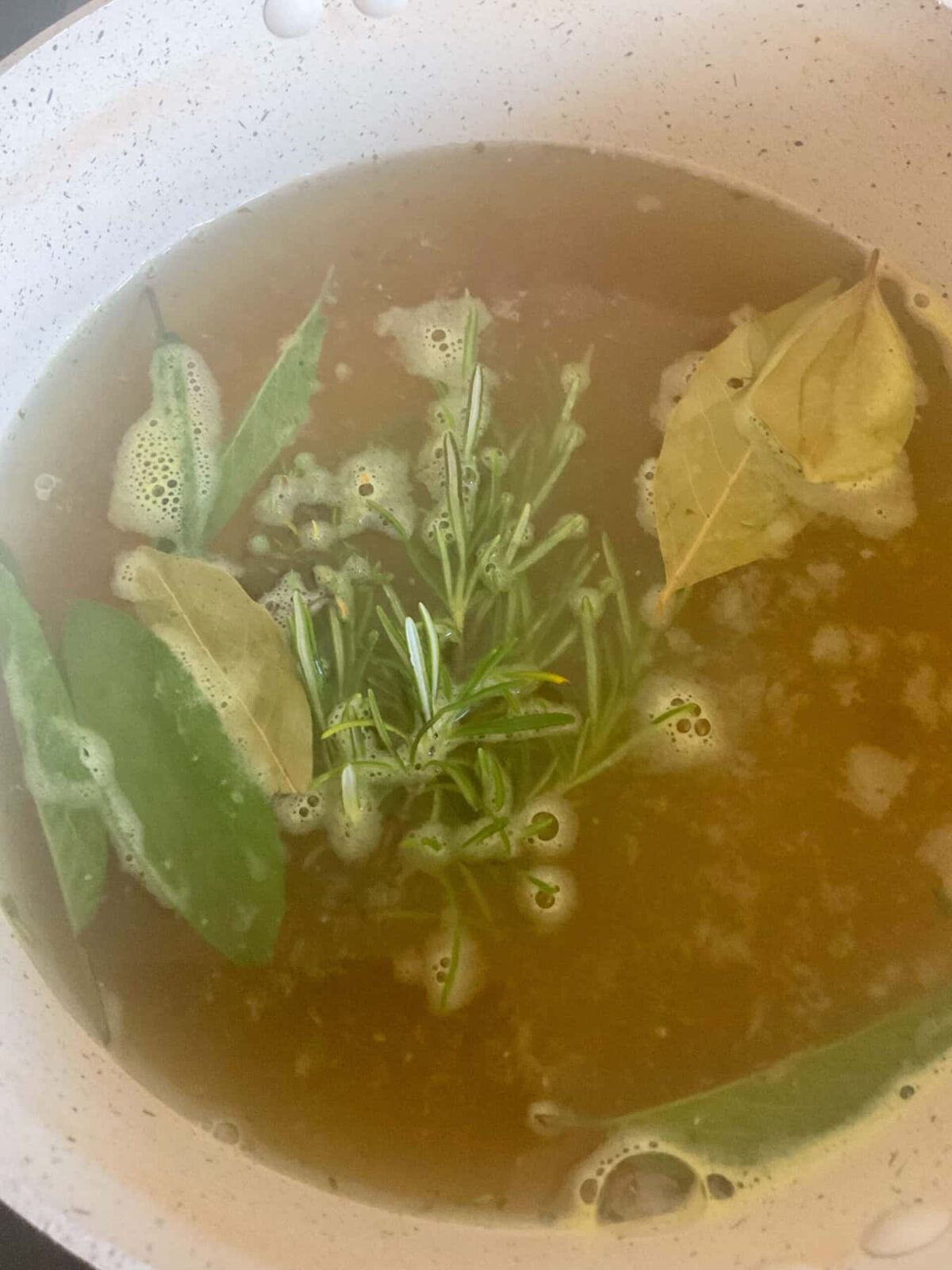
Step 2: Add the barley to the stew pot, along with the vegetable stock, marmite [yeast extract], bay leaf and any fresh herbs you like [we used sage, rosemary, and thyme]. Or replace the fresh herbs with dried herbs or use both.
Step 3. Bring to the boil, and simmer for 25 minutes.
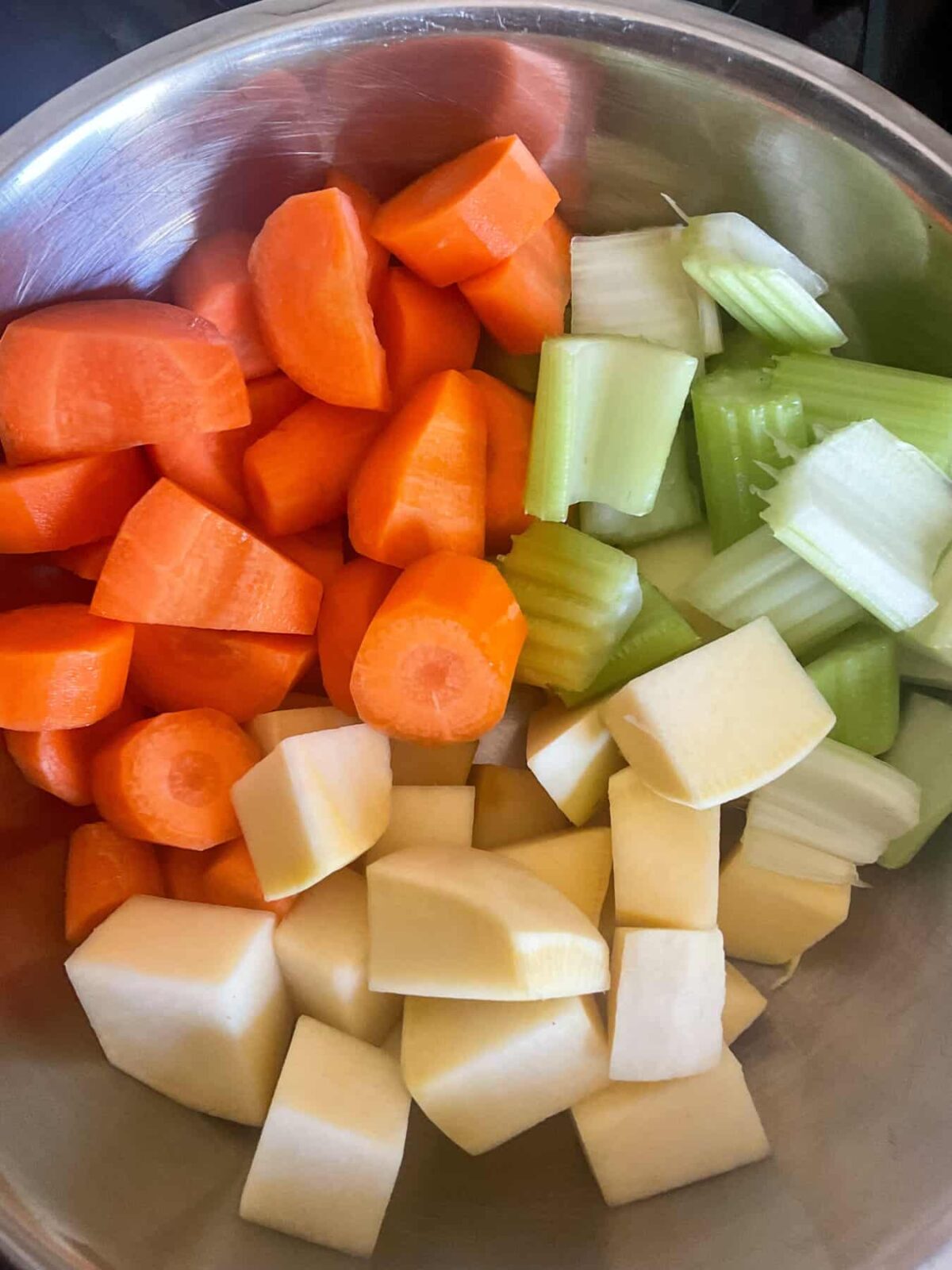
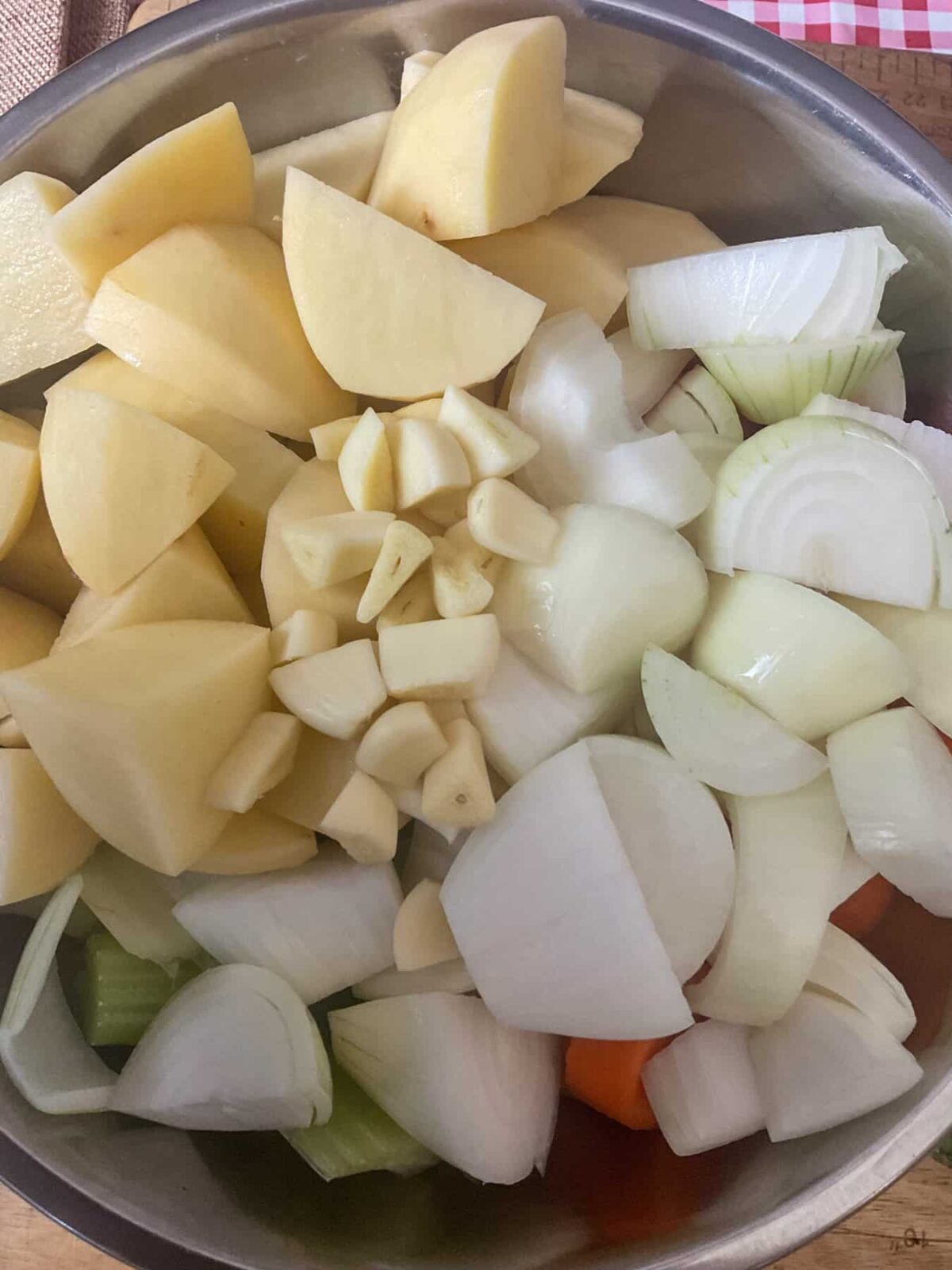
Step 4: Next, remove the dried herbs and add the chopped potatoes, carrots, celery, onions, swede, cabbage, and garlic, to the stew pot.
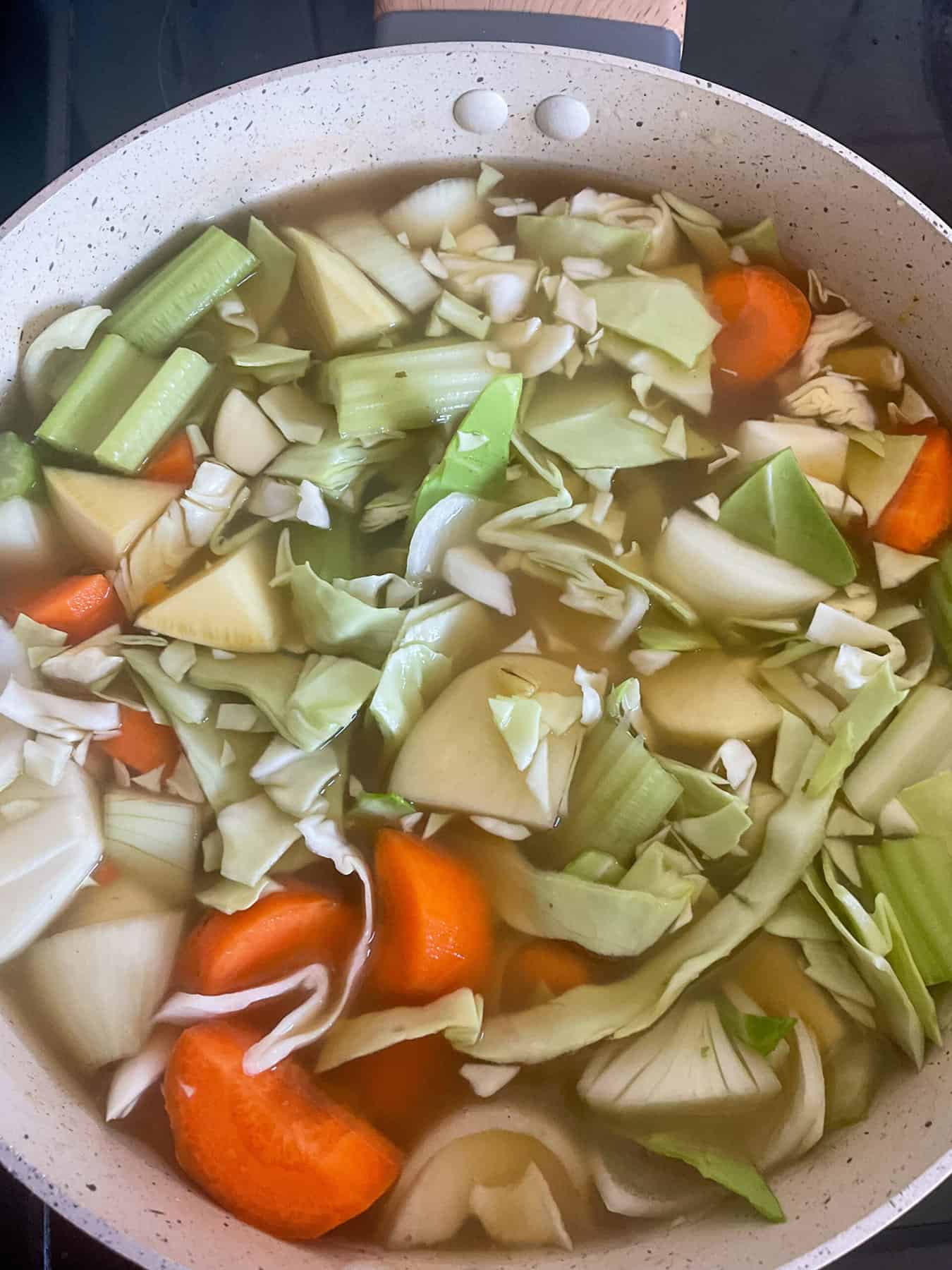
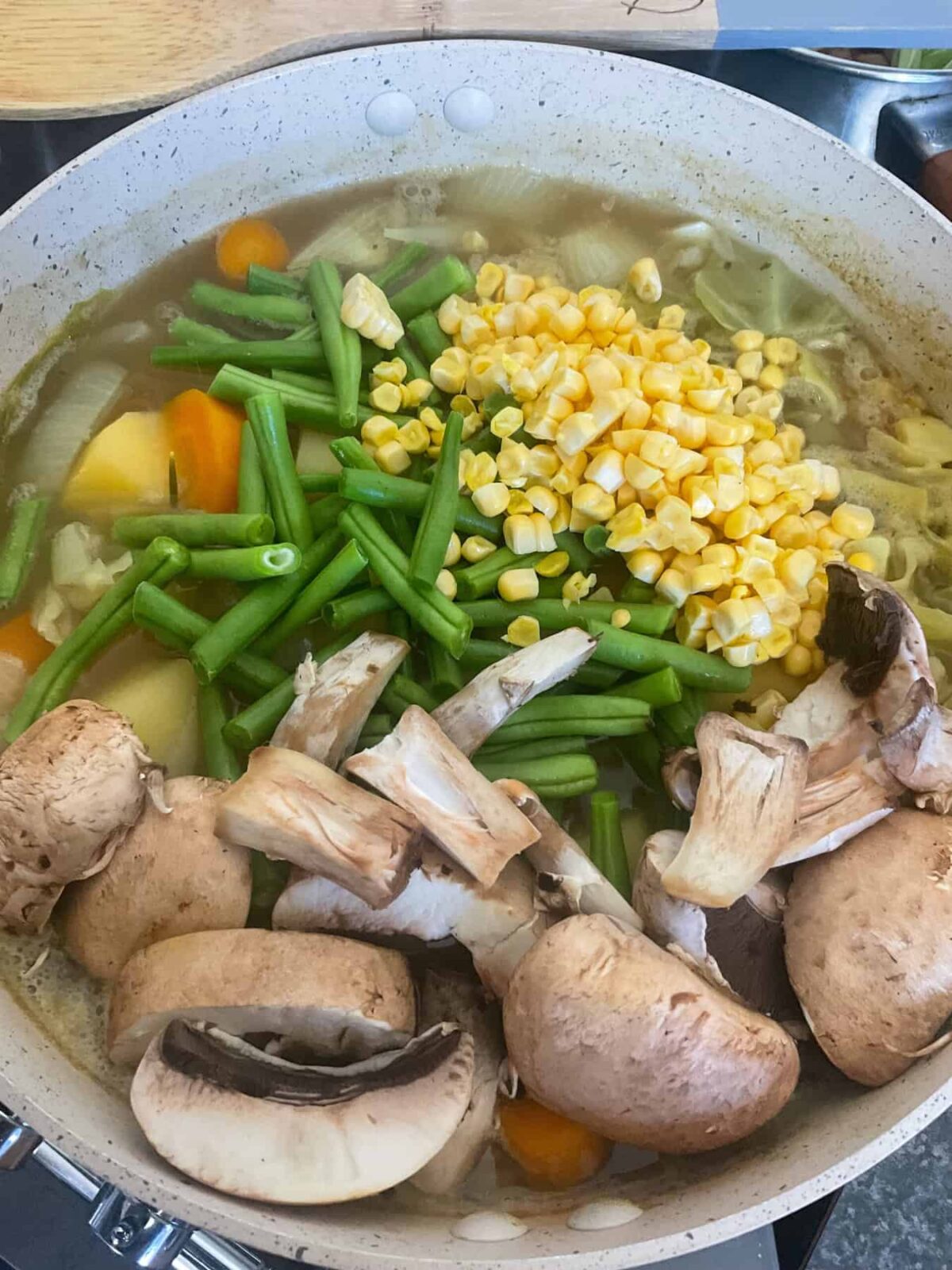
Step 5: Cook for 10 minutes, before adding the sliced mushrooms [we used chestnut mushrooms], green beans and sweetcorn.
Step 6: Cook for another 3 minutes.
Prepare the dumplings
The dumplings can be prepared with either vegetable suet or vegan butter that comes in a block form. See the main recipe for guidance on using vegan butter as an alternative.
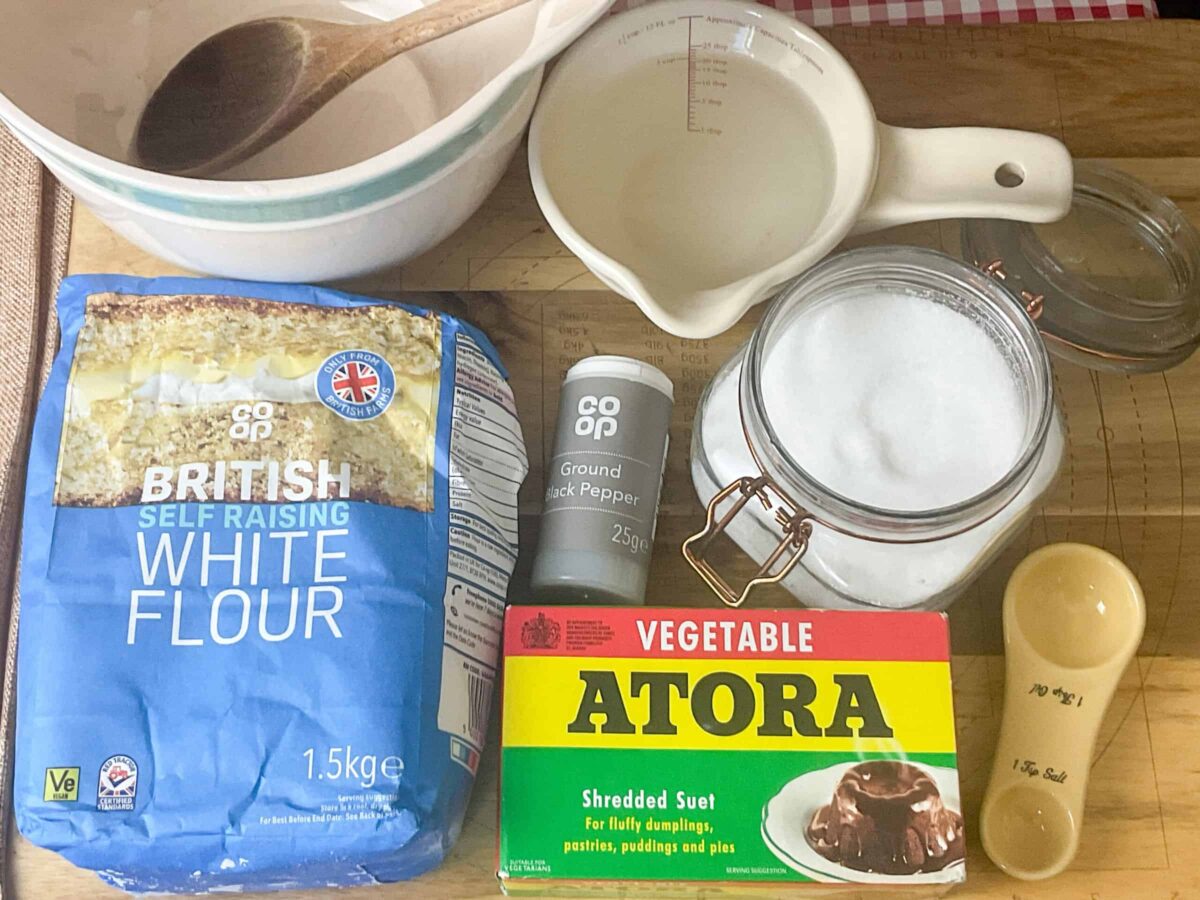
Step 1: Gather all your dumpling ingredients.
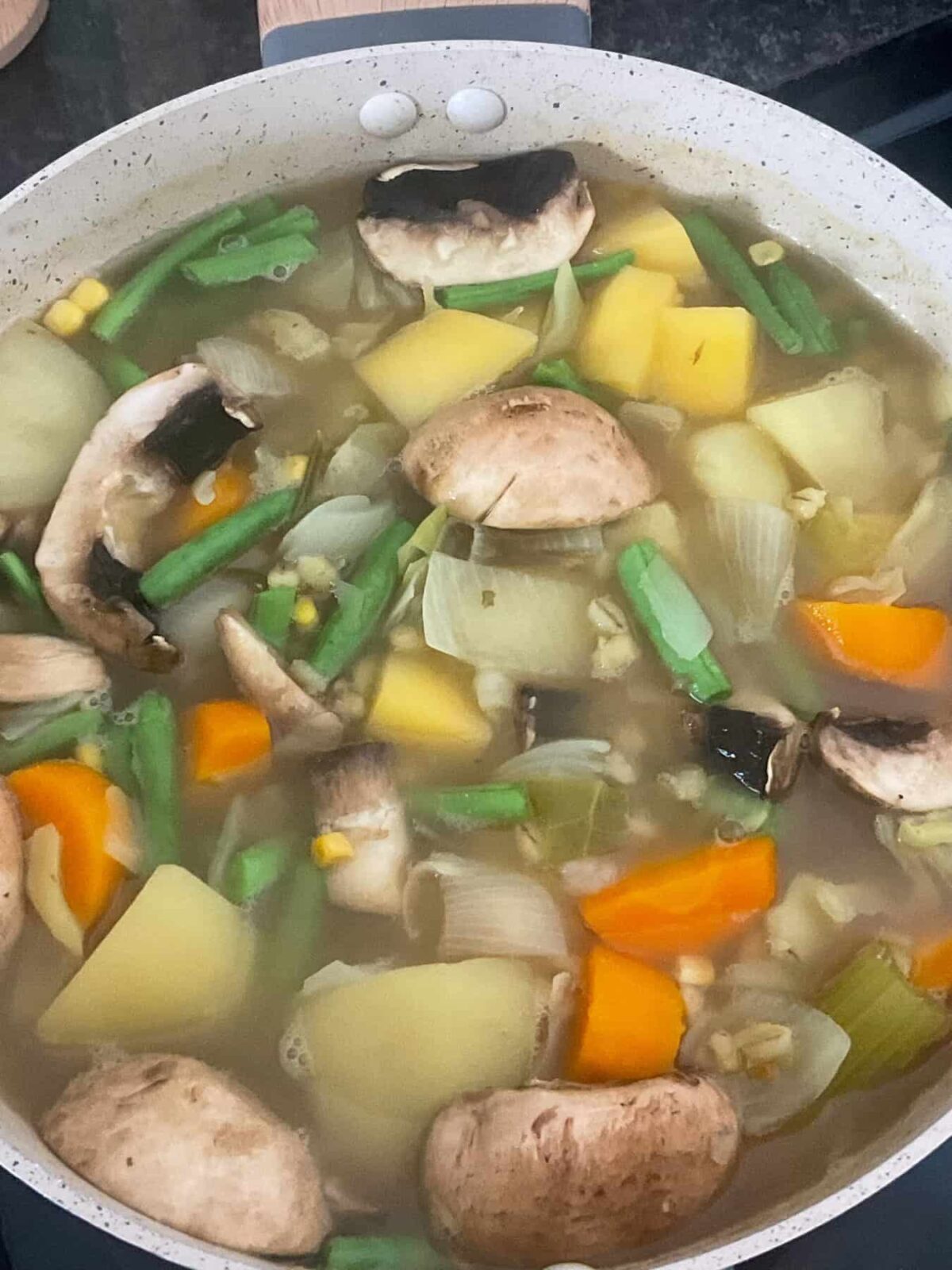
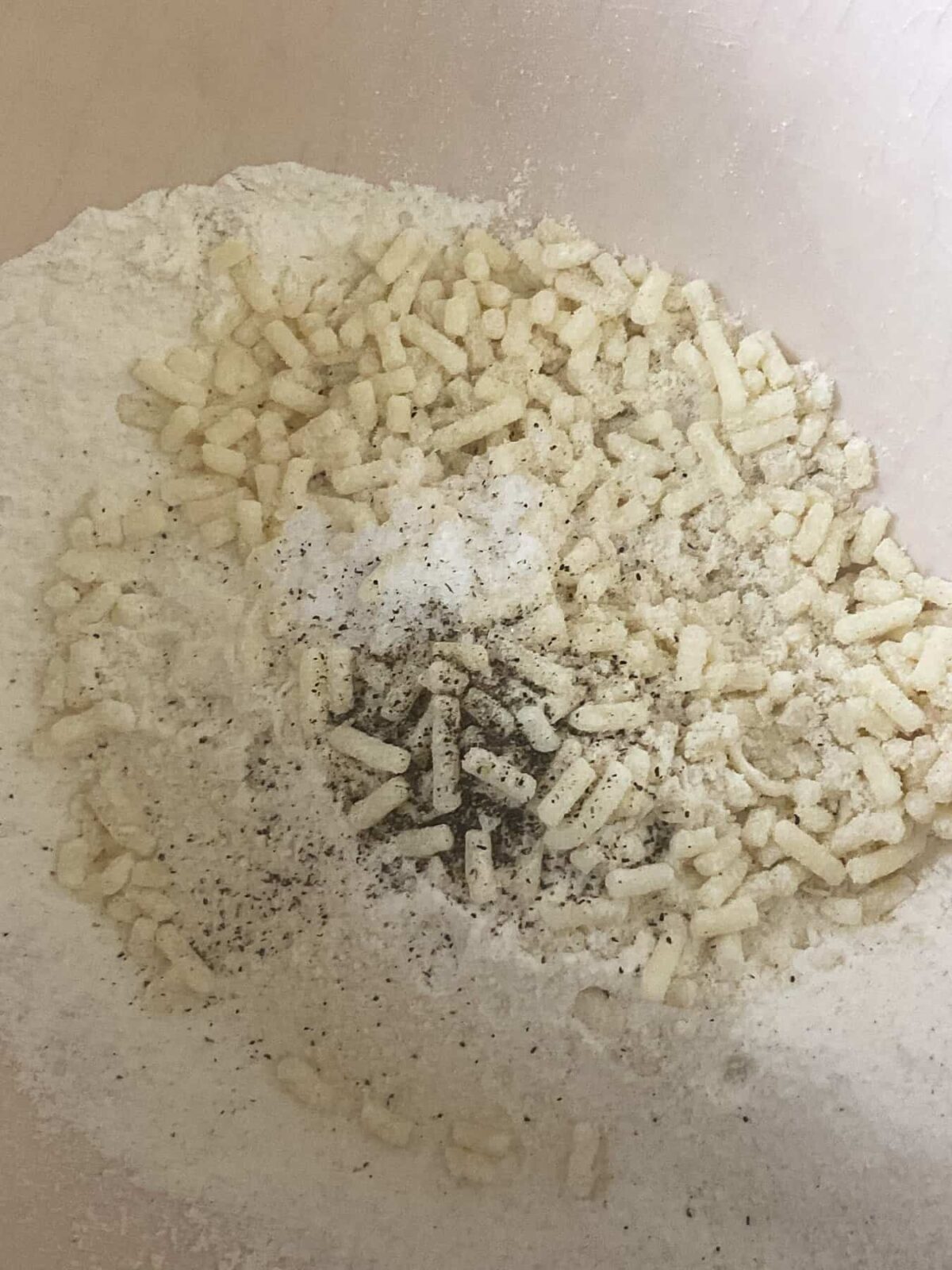
Step 2: While the vegetables in the stew are cooking the doughballs can be prepared.
Step 3: Add the self-raising flour, vegetable suet, salt and black pepper to a mixing bowl.
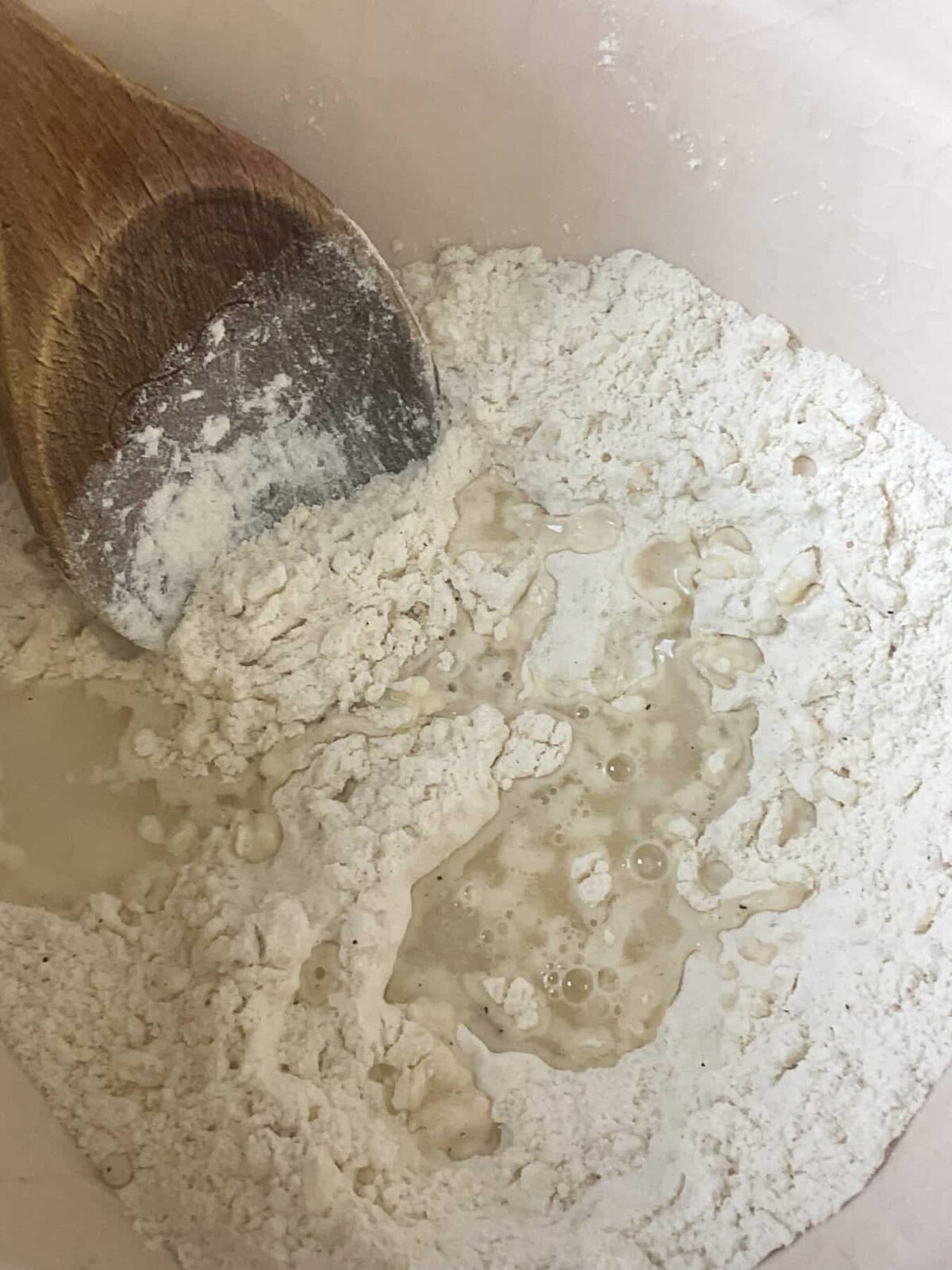
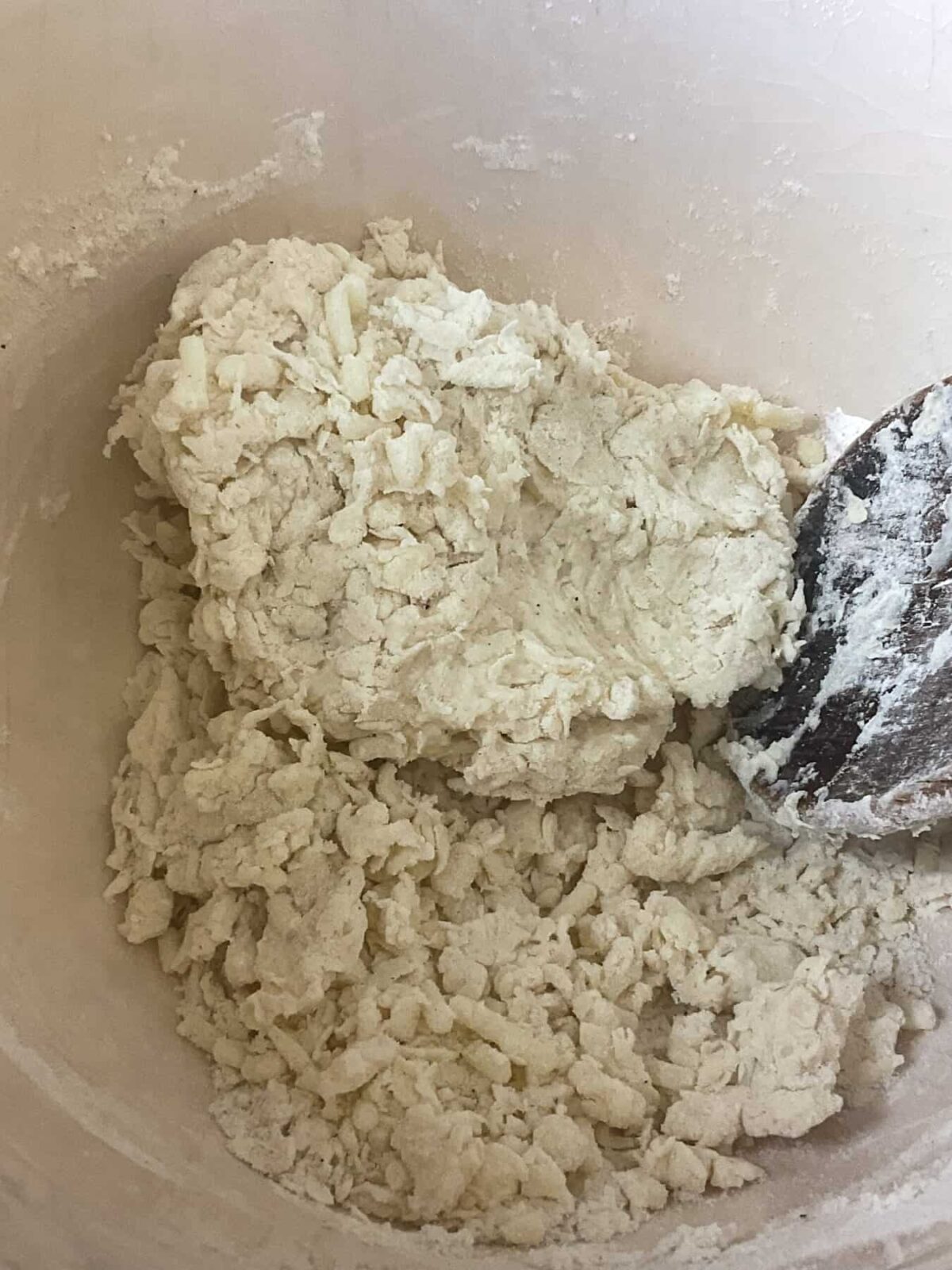
Step 4: Add 4-5 tablespoons of water to the dry ingredients and stir well until it begins to clump together.
Step 5: Using your hands press the dough into a ball shape, adding a few more drops of water if necessary.
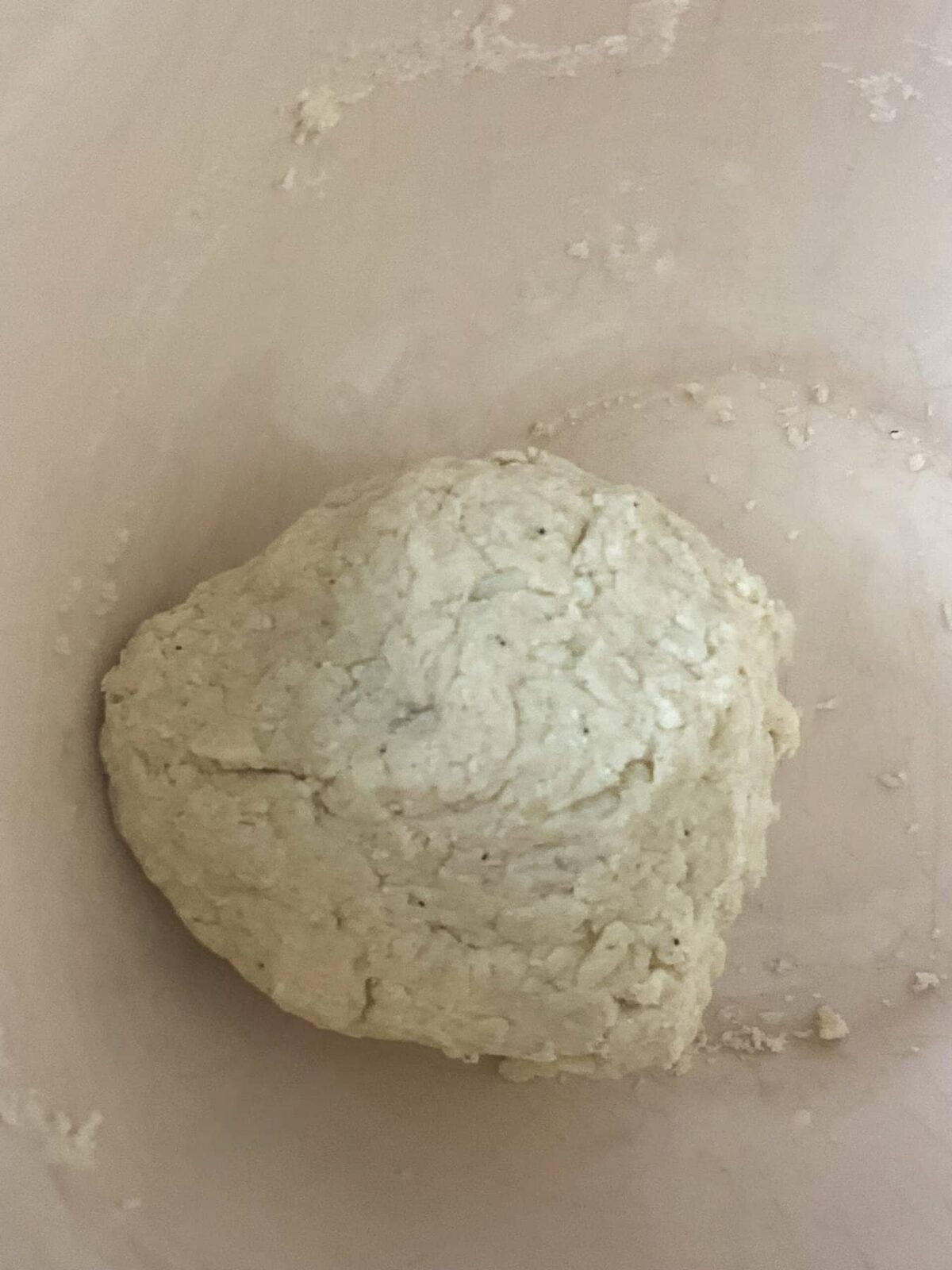
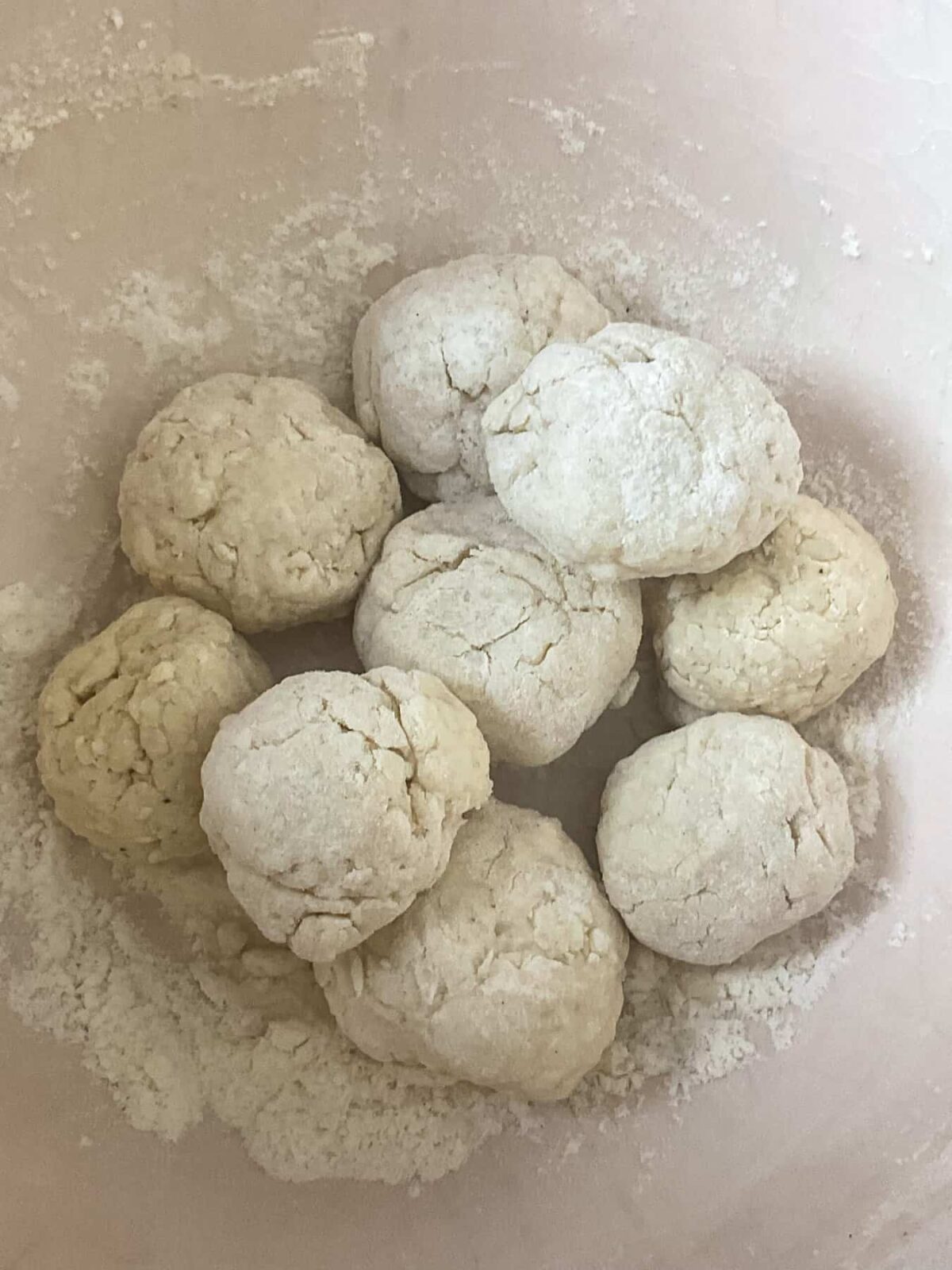
Step 6: Shape the dumpling dough into 8-9 small dumpling balls, dusting your hands with flour helps form the balls.
Step 7: Don't overwork or knead the balls too much.
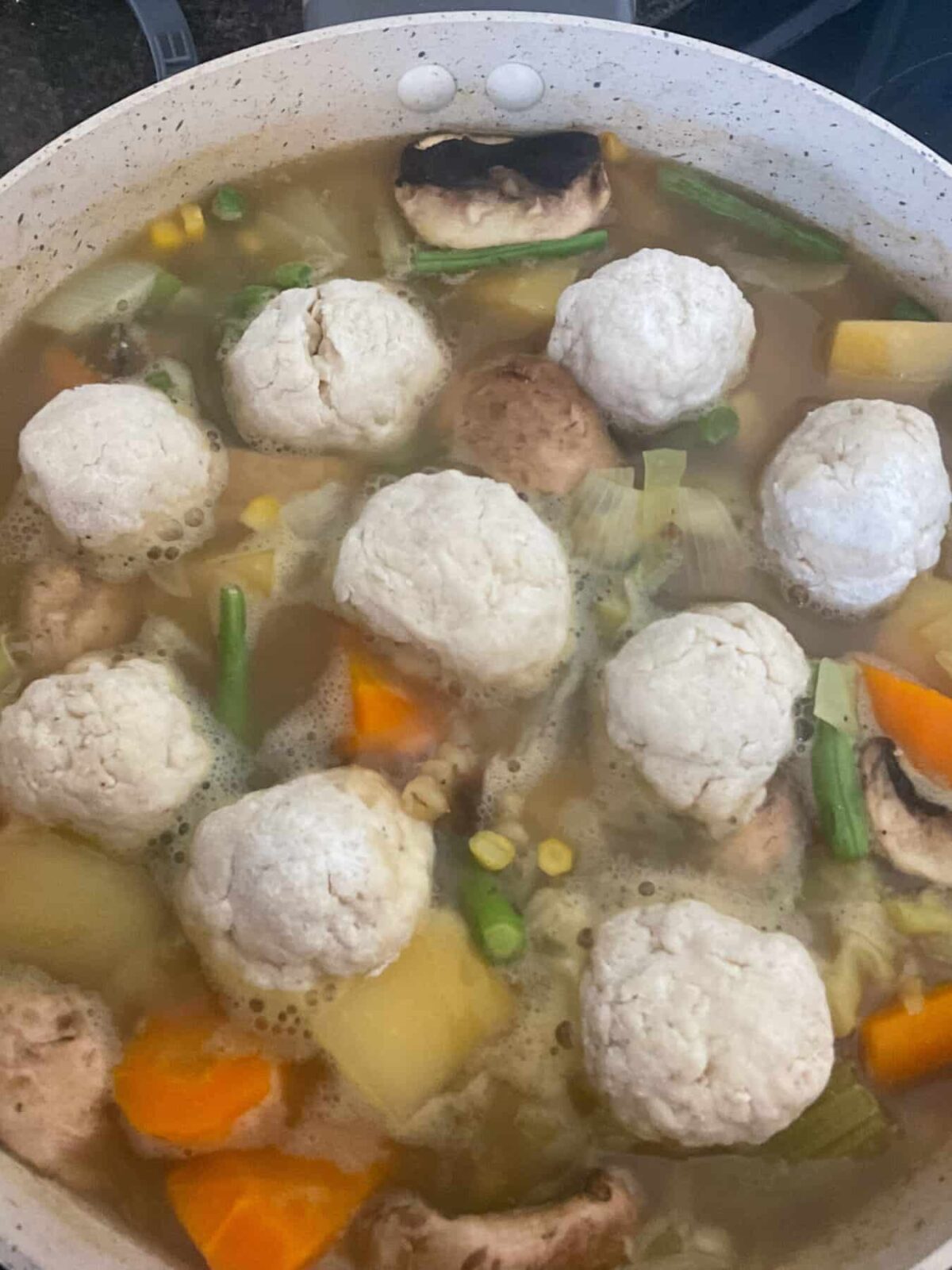
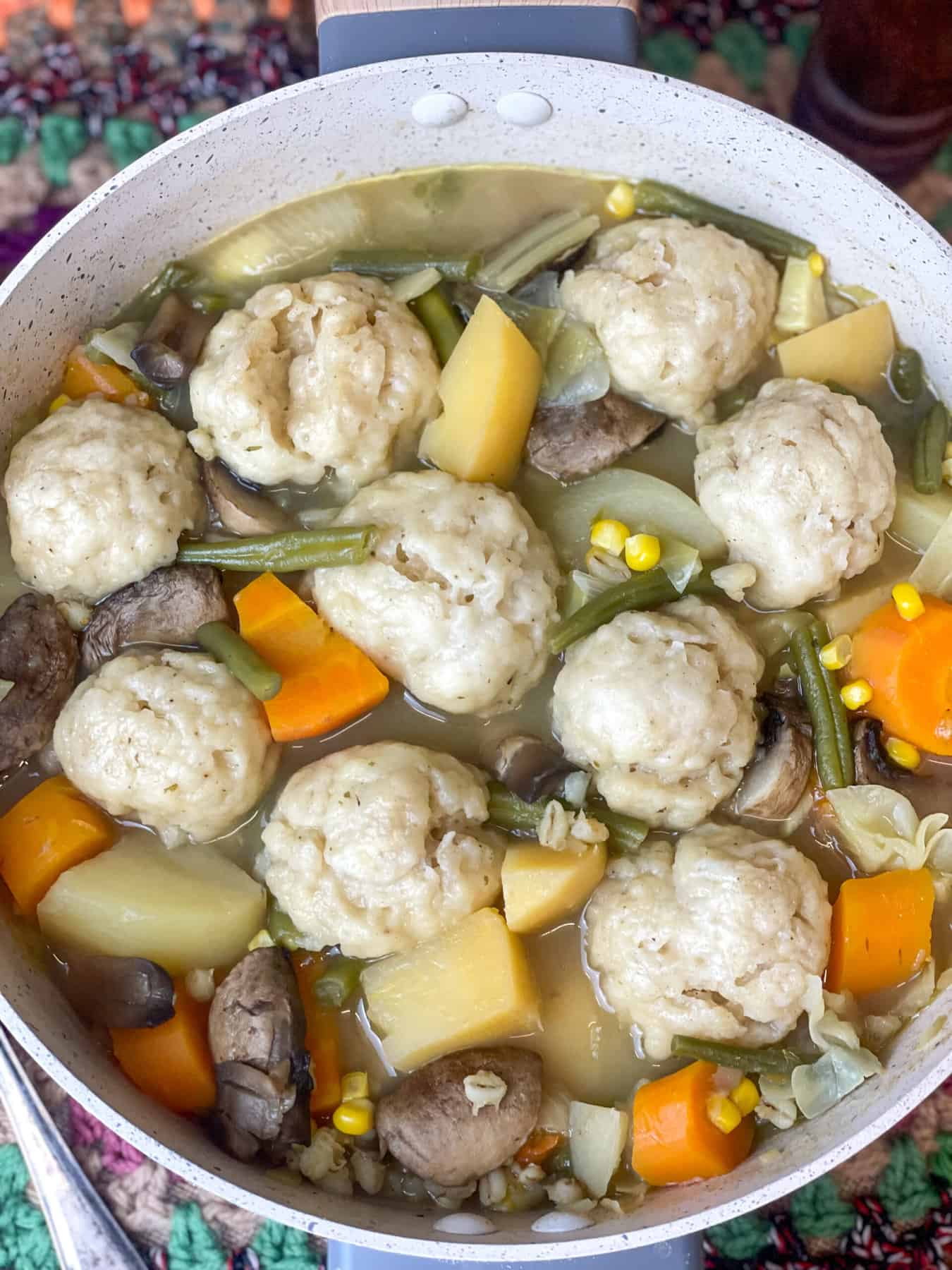
Finish the stew:
Step 1: Place the dumplings into the bubbling stew and pop a lid over the stew pan.
Step 2: Cook the dumplings for 20 minutes.
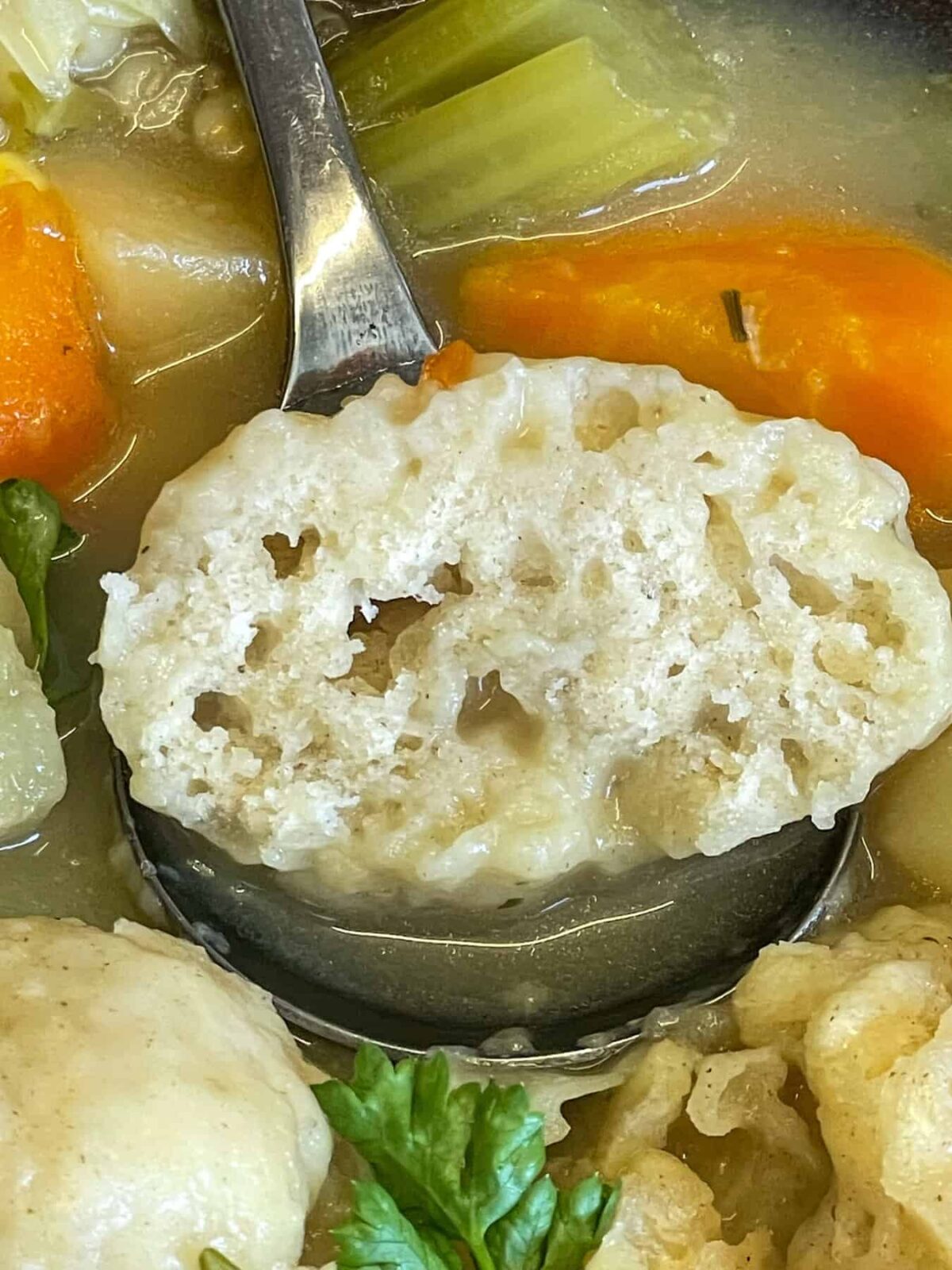
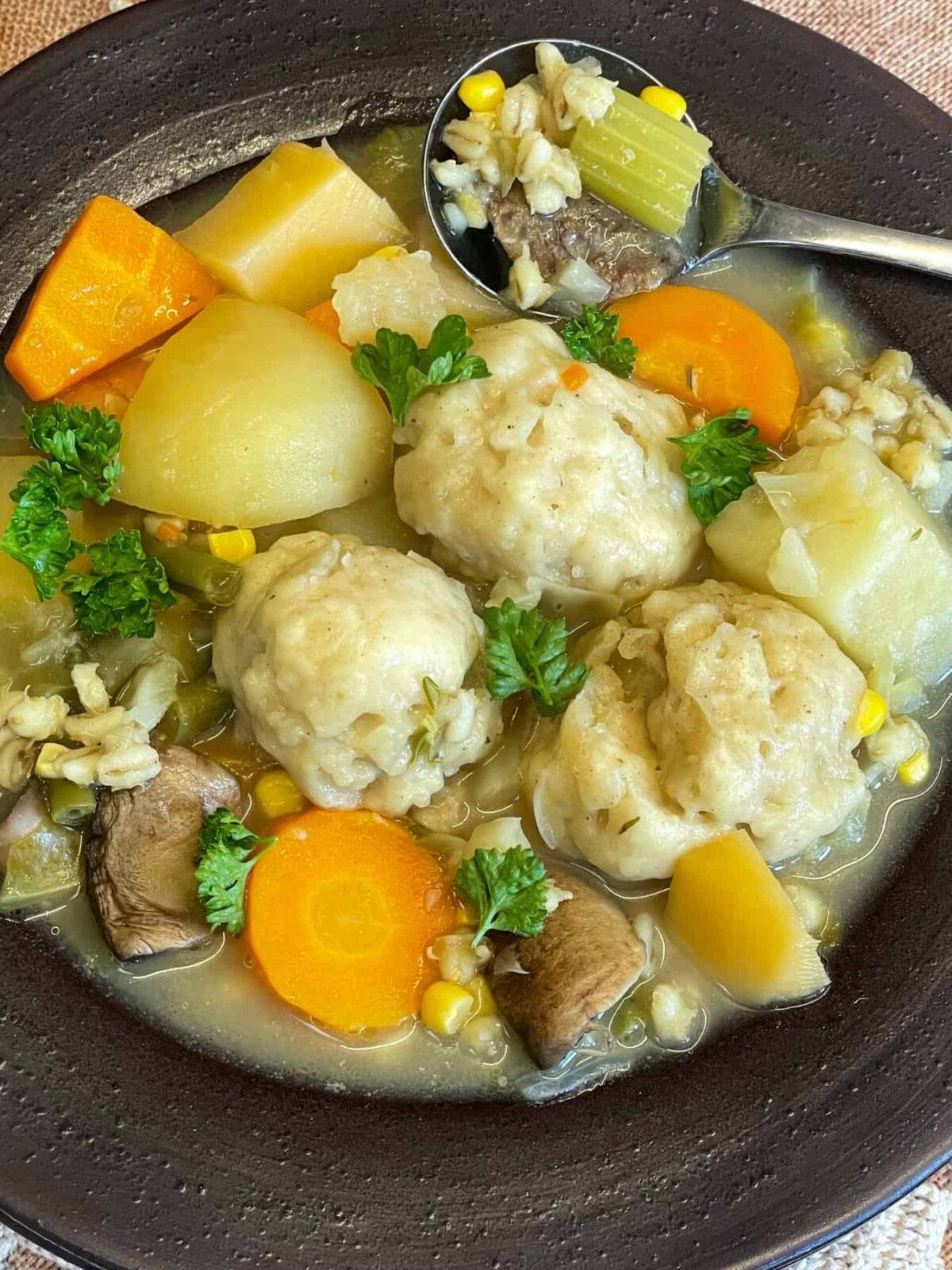
Step 3: After 20 minutes the dumplings will be deliciously plump and fluffy.
Step 4: Enjoy the vegetable stew with fresh chopped parsley if liked, and perhaps a few slices of bread to mop up the tasty veggie stew juices.
***please note: for US measurements click the 'US customary button' within the recipe and the measurements will switch to tablespoons, cups, and ounces.***
📖 Recipe
Traditional Vegetable Stew and Dumplings
Equipment
- Large non-stick soup or stew pot / Dutch oven pot with a lid
- Mixing bowl
- cutlery knife or spoon
Ingredients
Vegetable broth:
- 1 teaspoon marmite [or vege-mite, yeast extract]
- 1.5 litres vegetable stock [prepared with 2-3 vegetable stock cubes]
- 1 small bunch of fresh herbs [such as parsley, thyme, sage, rosemary, lovage, a mix is nice,] or replace with a few teaspoons of dried herbs
- 2 bay leaf
Stew:
- 100 grams pearl barley washed and drained
- 2 medium carrots [about 240grams prepared carrots sliced into 1 inch chunks]
- 2 sticks celery [about 140grams prepared celery sliced into 1 inch chunks]
- 2 medium potatoes [about 410grams prepared potatoes sliced into 1-1½ inch chunks] keep the skins on if unblemished
- 1 small swede [about 350grams prepared swede sliced into 1-1½ inch chunks]
- 1 medium onions [about 240grams onion sliced into thick pieces]
- 80 grams green beans [sliced into 1-2 inch pieces]
- 90 grams mushrooms [sliced into thick pieces, cut the stalks in half]
- 150 grams white cabbage [shredded and rough sliced] any type of cabbage can be used
- 70 grams sweetcorn [either fresh, frozen or canned] we removed the kernels from 1 corncob
Dumplings:
- 100 grams self-raising flour
- 50 grams vegetable suet
- ¼ teaspoon salt plus a few pinches of black pepper
- 5 tablespoons water [to bind the doughballs] may require a little less or more water
Optional:
- fresh chopped parsley
Instructions
Prepare the stock and pre-cook the barley:
- Add the pearl barley to the stew pot along with the vegetable stock, marmite, and bay leaf. If using fresh herbs add these too, or a few teaspoons of dried herbs can be used instead.1 teaspoon marmite, 1.5 litres vegetable stock, 1 small bunch of fresh herbs, 2 bay leaf, 100 grams pearl barley
- Over a medium heat, bring to a gentle boil, pop the lid over the pan covering about ¾ of the pot, and cook for 20 minutes.
- Remove the fresh herbs, and you can either remove the bay leaf or keep them in the broth.
Prepare the stew:
- Add the carrots, potatoes, onions, swede, and cabbage to the vegetable broth, and bring back to the boil and cook for 10 minutes. Place the lid over the pot so that it just covers about half of the pot.2 medium carrots, 2 sticks celery, 2 medium potatoes, 1 small swede, 1 medium onions, 150 grams white cabbage
- Give the stew a good stir, and add the mushrooms, green beans, and sweetcorn, and cook for another 3 minutes.80 grams green beans, 90 grams mushrooms, 70 grams sweetcorn
Prepare the doughballs:
- While the vegetables are cooking prepare the doughballs.
- Add the flour, suet, salt, and pepper to a mixing bowl and stir together.**[If using chilled or semi-frozen vegan butter instead of suet, use a cheese grater and shred the butter into small pieces directly into the flour mixture, if the butter pieces are large just use a cutlery knife or clean scissors to slice them up smaller being careful not to squash the pieces too much or rub them into the dry ingredients]**100 grams self-raising flour, 50 grams vegetable suet, ¼ teaspoon salt
- Pour in 5 tablespoons of water and using a cutlery knife or spoon stir the water through the flour mixture until it begins to look scraggly and is clumping together.**[ If you used vegan butter instead of suet you will likely need less water as the butter is more moist compared to suet, so just add 4 tablespoons and if too moist simply add a little extra flour]5 tablespoons water
- Dust your hands with flour, and form 8-9 doughballs [we usually prepare 9] using a few extra drops of water if necessary or a little extra flour if the dumpling mix is too wet. Its important to not overwork the dumpling dough so don't knead it on your work surface, rather just use your hands to form the dumplings - the dumplings do not have to be perfectly smooth balls, a few cracks are fine]
Finish the stew:
- After the mushrooms, sweetcorn, and green beans have had 3 minutes of cooking, give the stew a good stir and taste the stew, adding salt and pepper to taste. Also remove any bay leafs that may still be in the stew.
- Next, pop the dumplings into the stew and place a lid completely over the pot, and over a medium heat simmer [gently boil] for 20 minutes.
- Serve sprinkled with fresh chopped parsley if liked, and slices of bread to soak up the veggie stew juices for those with extra hungry appetites!fresh chopped parsley
Notes
- Nutritional information is provided for guidance only and is not intended to be an exact calculation as ingredients vary.
- Nutritional data is for 4 servings, but the stew may feed 6 if smaller appetites or smaller bowls are dished up.
- Prepare extra dumplings if liked [everyone always wants more!], and if necessary use a larger stew pot so that the extra dumplings fit!
- If half the stew was eaten on the first day along with all the dumplings, simply bring the rest of the stew to a gentle boil, adding extra vegetable broth to thin down the thick stew, and prepare a new batch of dumplings, and cook these in the pot on top of the leftovers. A cheap and easy meal, but totally delicious!
- The stew will become thick as it is stored as the barley will continue to absorb the liquid, so add extra broth or stock, and gently boil until piping hot.
- Store leftovers within the refrigerator for 3 days.
- Or freeze for 2-3 months.
- The dumplings will be at their best soon after cooking but can be reheated or frozen along with the stew.
- We sourced our dumpling recipe from the back of the Atora Vegetable suet packaging, but we added black pepper and stated an exact amount of salt.
- The suet can be replaced with chilled or semi-frozen block of vegan butter, see the recipe above for directions.
- For useful suet dumpling tips to help you prepare the best dumplings, check out the recipe notes and FAQ section above the recipe.
- The vegetables do not have to be perfectly cut so just go with rough chopped into chunks.
- Add more veggies if liked, the quantities are for guidance only, often when I make a stew I just chuck anything and everything in without weighing! That's the beauty of stews!
- Gluten-Free Vegetable Stew and Dumplings:
- For a gluten-free dumpling recipe see the celiac.org.uk recipe. For gluten-free vegetable stew use a gluten-free vegetable stock, broth, powder, or cubes. We used Marigold Swiss vegetable bouillon powder which is labelled vegan and gluten-free, also replace the barley with rice or buckwheat. And use a gluten-free certified yeast extract such as gluten-free labelled Vegemite or replace it with 1-2 tablespoons of tamari soy sauce or coconut liquid aminos.
Nutrition
Frequently asked questions
Yes of course. The dumpling recipe makes 8-9 dumplings, but if your stew pot is large enough for extra dumplings you could make an extra batch or half batch.
Barley can be replaced with a variety of different grains, although do keep in mind that other grains will have different cooking times as well as textures and flavours. A few suggestions are brown rice, rice, buckwheat, whole lentils, farro, quinoa, or bulgur wheat.
Absolutely any vegetable can be added to a stew, so simply go with what you have and enjoy.
We use potatoes, swede [rutabaga], carrots, celery, onions, mushrooms, green beans, cabbage, and sweetcorn, but here are a few more ideas: sweet potatoes, celeriac, peas, field beans, yard-long beans, mange-tout, sugar snap peas, kale, collard greens, spinach, spring greens, turnip, parsnip, beetroot [although this will colour the stew with pink-red tones!], courgettes [zucchini], marrow, butternut squash, acorn squash, pumpkin, etc.
Also consider the length of time it takes to cook any vegetable you add as some softer vegetables such as spinach and marrow do not need lengthily stewing times, whereas other vegetables such as butternut squash can cope with a longer cooking time.
Here are some tips to help you prepare the best vegetable suet dumplings:
1. Measuring the ingredients accurately is essential for the lightest, fluffiest dumplings, so do use a weighing scale if possible. The main ratio of flour to suet/butter is 2:1 so use half the amount of suet to your quantity of flour. Too much suet or flour can make your dumplings heavy and dense.
2. If replacing the vegetable suet with a vegan butter make sure that the butter comes in a solid block form and that it is very cold, chilled, or semi-frozen as this will ensure that the butter can be shredded with a cheese grater much more easily. See the main recipe for guidance on using vegan butter.
3. Be careful not to overmix the dough or knead it like bread dough as this can lead to tough dumplings! Simply form the dumplings using your hands into ball shapes without squashing them too much.
4. Allow the formed dumplings to rest for a few minutes before adding to the hot stew.
5. Ensure that your dumplings are not too large as they will increase in size as they cook and if you make them too large they may not cook properly in the time given by the recipe. Use the recipe as a guide to how many dumplings the mixture should be shaped into for best results.
6. Simmer or gently boil the stew liquid, and be careful not to fast or rapid boil while the dumplings are cooking as this can affect the dumplings shape and texture.
7. Leave some space between each dumpling so that they have some room to expand as they cook.
8. Always keep the lid on the pot whilst the dumplings are cooking as they are steam cooking, so try and resist the urge to lift the lid before the stated cooking time has finished.
9. Always follow the recipe cooking time for the dumplings and don't undercook the dumplings as the dough will be half raw! On average dumplings take around 20-25 minutes to cook through. They are done when they are plump, well risen, and when gently sliced in half the insides will be fluffy with air holes.
10. The number one tip is to not give up. If your first batch didn't go to plan keep trying as you will soon get the hang of making dumplings, and you won't need a recipe as the ratio 2:1 [flour: suet, so 100g/4oz of flour - 50g/2oz suet/butter] can be easily noted down and quickly recalled and added to any soup or stew you like. However, don't forget to add some salt and pepper, and maybe some dried herbs, and enough water to bind into dumplings.
A bowl of vegetable stew with dumplings and some crusty bread is a meal in itself. A slice or two of this home-baked Irish Soda Bread [100% wholemeal] or this Boston Brown Bread, is very nice dunked into vegetable stew juices, as is one of these Cornbread Muffins, Vegan Cheese Scones, and Vegan Buttermilk Scones.
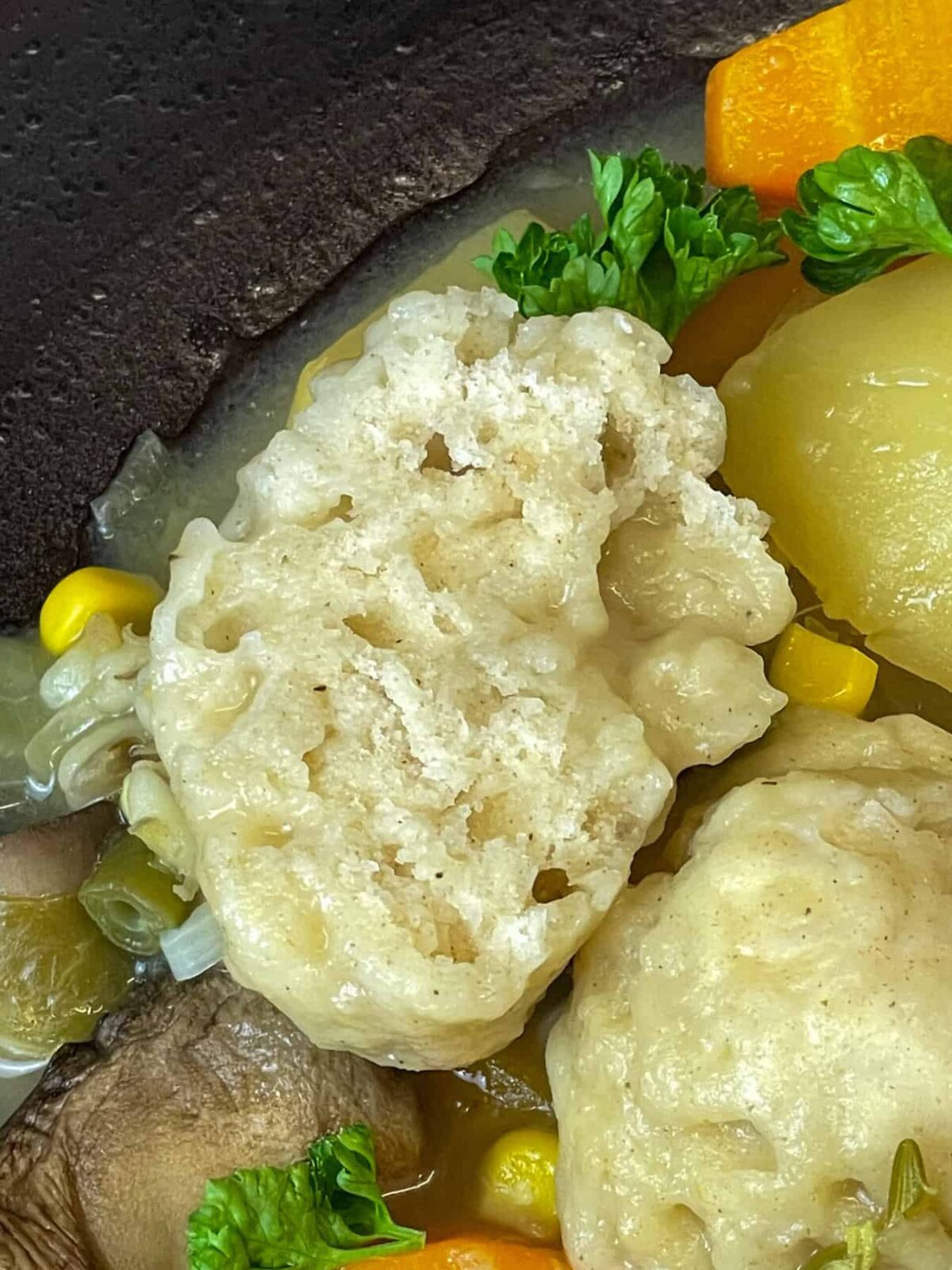
More vegetable stew recipes
Vegetable stews are the perfect comfort food and are just so easy to prepare. They can be tailored to whatever ingredients you have to hand, and are incredibly budget-friendly as even the saddest looking vegetable in your refrigerator can be transformed into a delicious pot of wholesome goodness. We have even added bendy celery sticks and carrots to a vegetable stew and they have been revived as they cook.
As we are a plant-based family our vegetable stew recipes are prepared with everyday ingredients that happen to be also vegan-friendly ingredients.
A few of our family favourite stews are this Slow Cooker Vegan Beef Stew and Dumplings and this Vegan Chicken Stew with Dumplings. For something a bit different but tasty we always love this Vegan Creamed Beef and Barley Stew and this fun Vegan Chuck Wagon Stew.
Accompaniment for vegetable stews
Homemade dumplings are a delicious addition to a vegetable stew but sometimes a quick home-made bread is quite nice as well. We particularly enjoy this easy home-made Australian Damper Bread or this Irish Soda Bread. For something a bit different we like these Old-Fashioned Cheese Scones and these Buttermilk Plain Scones.
As we are a plant-based family we use dairy-free milk, butter & margarine, and cheese but of course if you have different dietary requirements our recipes will work fine for your usual ingredients.
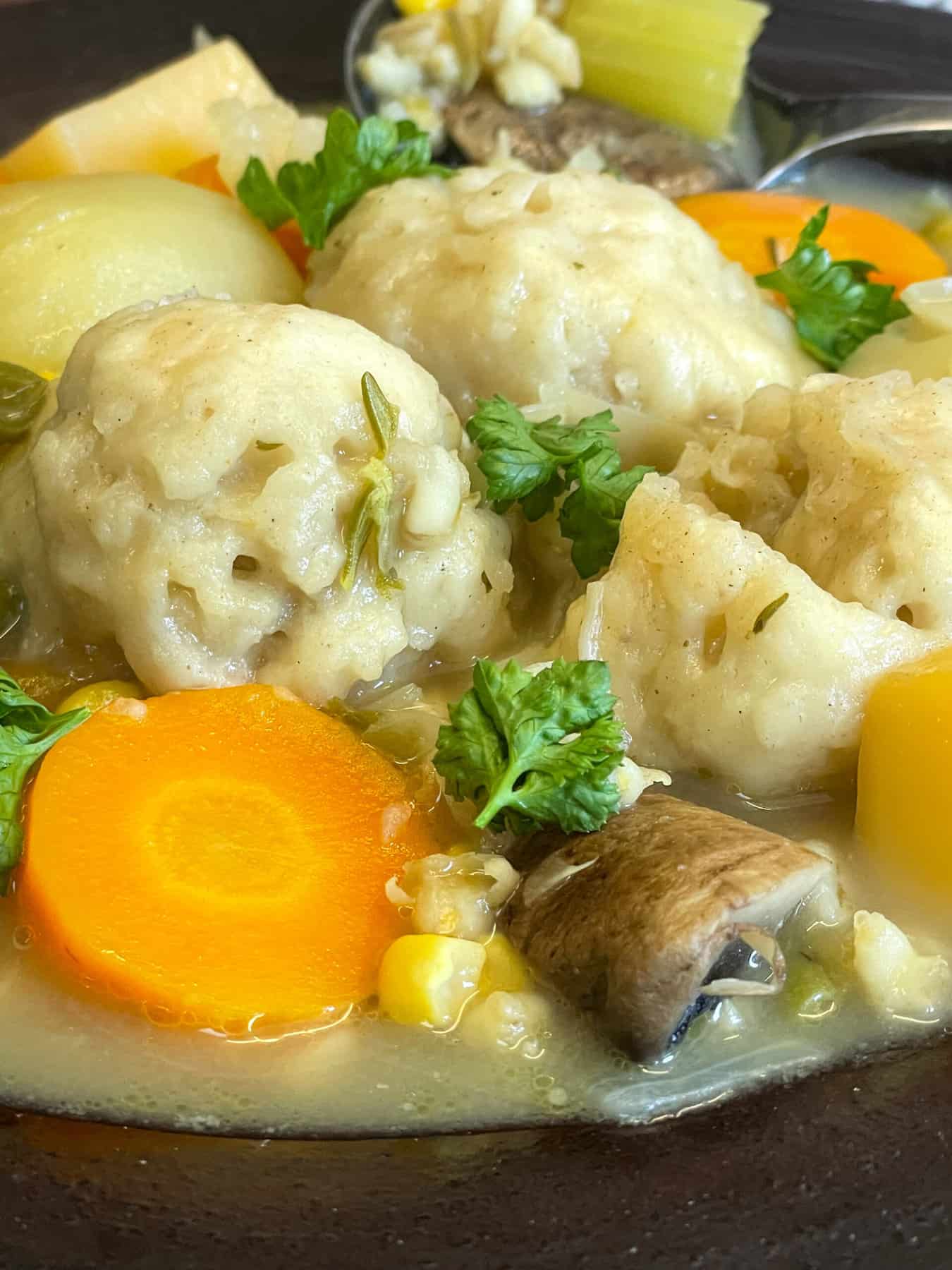
Comments
Prepared our tasty Traditional Vegetable Stew and Dumplings? Do pop back and let us know how you got on with the recipe as we love hearing from you. Thanks so much! Jacq x
Leave a Reply